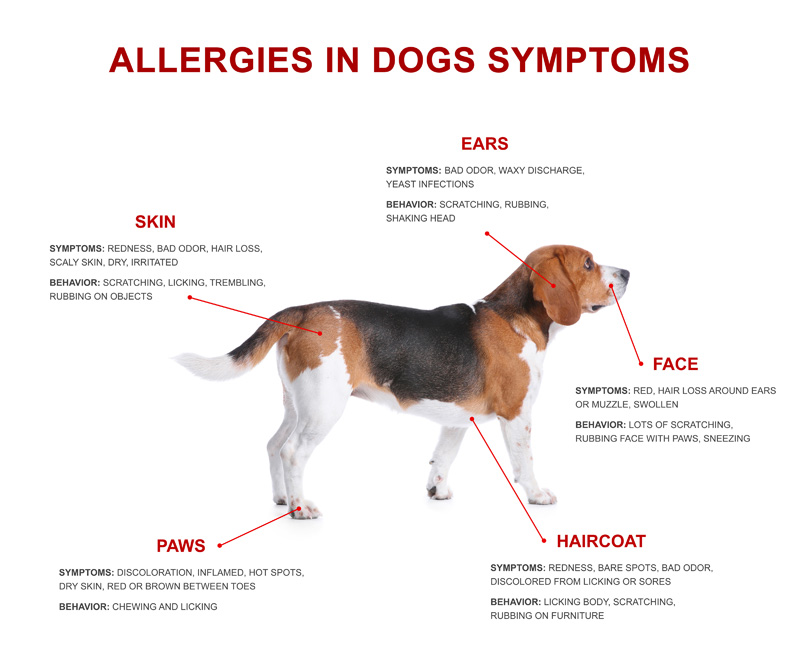Top 10 Most Common Allergies in Dogs

Have you noticed that your dog seems preoccupied with licking its paws? How about other subtle changes like weight loss, lethargy, or aggressiveness? You might be surprised to know that these instances are standard signals of allergies in dogs.
It is estimated that 10% of dogs have allergies, and popular breeds like golden retrievers, Labrador retrievers, and terriers are more susceptible to developing different types of allergies. Ahead, we’ll break down the top ten most commonly diagnosed allergies in dogs as well as tips for managing irritating symptoms.
What Are Dog Allergies?
Like their human counterparts, dogs experience similar allergic reactions to certain substances. The three most common types of allergies in dogs are skin, food, and environmental.

While dogs can develop allergies at any age, most symptoms will begin to show between 1-3 years old. Suppose you believe your dog is suffering from allergies. In this case, it is essential to contact your veterinarian, who can administer a series of tests to identify the root source of your dog’s symptoms. Before we delve into diagnosis and treatment, let’s explore the allergies in dogs most frequently identified in veterinarians’ offices.
1. Flea Saliva And Bites

Flea allergy dermatitis (FAD) is the most commonly observed allergy in dogs. The saliva from a flea’s bite can cause skin inflammation and itchiness, potentially resulting in hair loss, open wounds, and scabs in the affected areas.
Pet owners may be more likely to notice signs of FAD at the base of their dog’s tail and thighs. The symptoms may be so uncomfortable that a dog might gnaw and scratch at its own skin, further exacerbating the risk of a bacterial infection.
2. Environmental Allergens
In a dog’s home environment, allergens like dust, mold, and pollen can cause atopic skin reactions that prompt your pup to lick its skin incessantly. Usually, pet owners will notice signs of atopic dermatitis around the paws and ears, but it can also be found between the toes, around the eyes, and at the dog’s underarms.
Susceptibility to atopic dermatitis is partly determined based on genetic factors, though environmental allergens can act as a catalyst to bring about frustrating symptoms.
3. Food Allergens
When your dog has a food allergy, it is typically because its digestive system cannot process a particular ingredient or component of the food, like a protein or complex carbohydrate. The most common food allergies include the following ingredients:
- Beef
- Dairy (technically an intolerance to lactose versus an allergy)
- Wheat
- Eggs (particularly the egg yolk)
- Poultry
- Lamb
- Soy
Pet owners will not typically notice food allergies in dogs until after prolonged exposure to a particular brand of food, and symptoms include itchy skin, diarrhea, and vomiting.
4. Insect Bites And Stings

Ouch! Bee and wasp stings are common culprits of allergies in dogs and can even initiate anaphylactic responses in some pups (though rare). If your dog starts to develop hives or swelling of the face, lips, eyelids, or earflaps, those are all potential signs of an insect sting. The good news? Such occurrences are rarely fatal and can be treated with an antihistamine prescribed by your veterinarian.
5. Plants and Allergies in Dogs
While it may seem obvious to steer your dog clear of plants like poison ivy, poison oak, and poison sumac, there are a host of other popular plants and flowers that are toxic to dogs, frequently causing them to have mild to severe allergic reactions.
Examples of plants that cause allergies in dogs include goldenrod, ragweed, and dandelions. Types of trusses (like Bermuda grass and Kentucky bluegrass) or flowers (such as daisies and marigolds) are other usual suspects. You can read more about the most toxic plants for dogs here.
6. Medications
Just like humans can have adverse reactions to medications, so can their canine friends. Antibiotics, vaccines, and even preventative flea and tick medications can cause allergic reactions in dogs.
Always make sure to consult your veterinarian before administering medication to your dog. In cases of allergic reactions, your dog’s vet may recommend ceasing the medication and using antihistamines or corticosteroids to mitigate allergic symptoms.
7. Contact Allergens
Do you notice that your dog is more fixated on scratching or chewing at their skin when they’re in a certain location of the home? Contact allergens from materials like wool, plastic, and latex can cause your dog to itch and swell.
Check the materials of your couch and chairs, bed, rugs, or other areas where your dog likes to spend time. It could be that a wool blanket or plastic toy is causing inflammation. If removing a nice couch or chair isn’t feasible, you might consider using a furniture cover to see if that helps relieve your dog’s symptoms.
8. Smoke And Pollution
Cigarette smoke, smog, and car exhaust can trigger allergies in dogs. Cigarette smoke, for example, contains toxic chemicals like nicotine, tar, carbon monoxide, and formaldehyde. These irritants can inflame the mucous membranes in a dog’s nose, throat, and lungs, potentially leading to worse respiratory challenges like lung cancer.
9. Cleaning Products
It’s true – even cleaning products can be the reason why your dog is experiencing an allergic reaction. Bleach and ammonia may cause skin and respiratory issues, along with disinfectants like Lysol and Clorox. Even particular laundry or dish detergents may initiate allergies in dogs.
Suppose you notice that your dog is showing typical symptoms of allergies. In that case, you may want to audit your household cleaning items (including fragrances) and
eliminate them from your cleaning routine to see if doing so improves things for your dog. You can also check the label of cleaning products for chemicals that may be toxic to dogs.
10. Stress and Anxiety
While stress is technically not an allergy, experiencing chronic anxiety and stress can lead to a weakened immune system, which can, in turn, make dogs more prone to developing allergies and other health problems.
What are the most common dog stressors? Separation anxiety, frequent environmental changes or disruptions, loud noises, and lack of socialization are all potential stressors that can keep a dog stuck in the stress response. Chronic stress can lead to an overactive immune system and trigger inflammation throughout the body, similar to what you’d notice with an allergic reaction in a dog.
How Are Allergies in Dogs Diagnosed and Treated?
Red eyes, hair loss, diarrhea, inflammation…you’ve noticed the obvious signs of allergies in dogs, and set up an appointment with your vet to identify the cause of your dog’s distress. So what happens next?
Allergy Test
To diagnose allergies in dogs, your veterinarian may propose an allergy test. With food allergies, for example, the vet may put your dog on an elimination diet, in which they eat a new source of protein and carbohydrates for an extended period. If your dog’s symptoms disappear during this timeframe, you can reintroduce its old food to determine what may have been causing the symptoms.
In cases of insect allergies, the vet can check for bites and administer a medication that kills bugs before they can even think about biting your dog. Avoiding allergic reactions is just one reason to keep your dog on a monthly flea/tick/heartworm preventative medication. Other methods of diagnosing allergies in dogs include blood tests.
Treatment
Typically, your dog’s treatment regimen could include several recommendations based on the type of allergen they are encountering. Allergy relief medication in pill form or topical treatment is frequently prescribed to relieve symptoms of itchiness, redness, and scabs from scratching or chewing at the skin. As mentioned, special protein diets can work wonders for dogs with food allergens. Dog owners may alternatively need to make changes in the dog’s environment, like switching household cleaners, relegating cigarette smoking outside while the dog is not around, or digging up toxic plants.
While food allergies in dogs cannot be cured, it is certainly possible for dog owners to avoid toxic or triggering ingredients with a hypoallergenic diet. Know that if your dog is allergic to one ingredient, it is likely to develop other food allergies in the future or be more susceptible to environmental and flea allergies. The best way to keep your dog safe, comfortable, and happy is to schedule regular visits with your veterinarian and closely monitor abnormal signs or behaviors. Your pup will thank you for your vigilance.
For more information about this subject or general questions you can contact:
Courie Dennis with Posh Paws Pet Care, LLC
843.900.0438
Visit our website at PoshPawsPetCareSC.com
Or send us a note from our contact page here.
